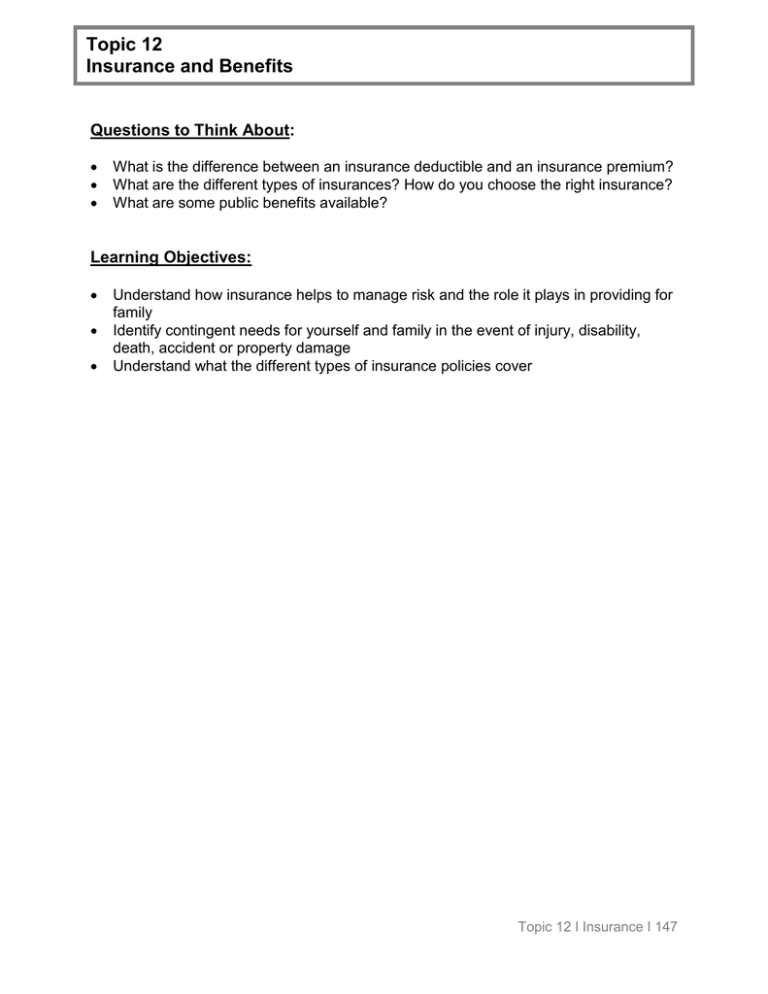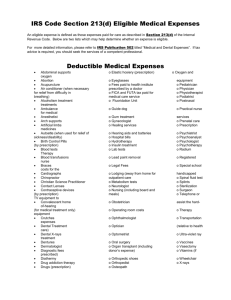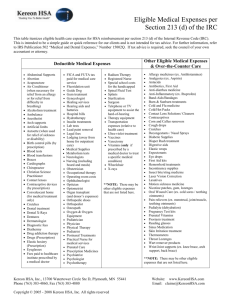
Topic
12
s
Insurance and Benefits
Questions to Think About:
What is the difference between an insurance deductible and an insurance premium?
What are the different types of insurances? How do you choose the right insurance?
What are some public benefits available?
Learning Objectives:
Understand how insurance helps to manage risk and the role it plays in providing for
family
Identify contingent needs for yourself and family in the event of injury, disability,
death, accident or property damage
Understand what the different types of insurance policies cover
Topic 12 I Insurance I 147
Topic 12 I Insurance I 148
Topic 12 I Insurance I 149
HEALTH INSURANCE
What is Covered?
Covered services listed under policy as are services not covered
Covered services may not include what doctor thinks is “medical necessity”
because service is not among “covered services”
“Usual and customary expenses”: charge for health care consistent with average
rate or charge for identical or similar services in geographical area
Sometimes referred to as “reasonable” charges
What if my insurance company refuses to pay for treatment or a
prescription recommended by a doctor?
If the treatment is not covered, the patient will have to pay for it
The client may file an appeal of claim but the outcome will be dependent on the
contract terms
Flexible spending plans – Pre-tax dollars set aside to pay for expenses not
covered by insurance
May be used to cover deductibles
Cover expenses generally deductible as medical expenses under IRC
No IRS cap-employer sets cap
Use it or lose it
Topic 12 I Insurance I 150
BASIC COSTS COVERED BY HEALTH INSURANCE POLICY
Basic Hospital Services – Semiprivate room, food, emergency room, nursing,
intensive care, ambulance service, medicines, X-rays and lab tests. Cost of private
room not covered unless it’s a “medical necessity”
Surgery – Surgeons, assistant surgeons, anesthesiologists, and outpatient surgery;
Plan covers “usual and customary” costs
Outpatient Care – Procedures previously needing hospitalization now done on
outpatient basis. To avoid infections and other unforeseen complications, policy
should provide adequate home healthcare support.
Home Health Care – Will cover part of home health care costs only if it’s ordered by
a doctor
Most Doctor Bills – Full or part where charges are “usual and customary”
Coverage for Children – Include stepchildren and foster children if policy-holder is
responsible for their support. Remain covered up to age 19; up to 21 or up to 25 if
full-time students.
Children with Mental or Physical Disabilities – If the children are unable to
support themselves, they should be covered permanently, if disability occurred while
they were insured.
Care for Infant From Moment of Birth – Required to notify insurer of birth within
30 days — most plans provide infants with major medical coverage from birth; may
not cover therapy for all birth defects
Convalescing in Nursing Home – Will cover part of cost; After hospital stay, but
nursing care still required
Prescription Drugs – May cover part of the cost of prescription drugs
Mental ,Drug & Alcohol Abuse Treatments - May cover part of the cost of
treatments
Most Incidental Expenses – Physical therapy, oxygen, durable medical equipment
(DME), e.g. wheelchairs, walkers
Topic 12 I Insurance I 151
Topic 12 I Insurance I 152
NOTE:
72 million American adults (41%) of adults under the age of 65 had problems related to medical
bills or accrued medical debt
49 million American adults under age 65 had medical debt – 28% of the population
The vast majority of those with medical debt (61%), had insurance at time of the medical
incident
- The Commonwealth Fund, Health Insurance Survey 2007
Majority of non-credit related bills in collection are associated with medical bills (52%)
Bills in collection considered to be a type of major derogatory
Such bills have an important effect on consumer’s ability to obtain credit
- An Overview of Consumer Data and Credit Reporting – Federal Reserve Bulletin 2003
Topic 12 I Insurance I 153
LIFE INSURANCE
Benefits are paid to designated “beneficiary” in case of death of insured, i.e. “death
benefit”
Provide for loved ones as an income replacement
Provide for funeral and burial costs
Types of Life Insurance
Whole Life – Level death benefit and a level premium; has cash value and pays
dividends
Universal Life – Permanent life insurance based on a cash value, i.e. policy
established with insurer and premium payments above the cost of insurance are
credited to the cash value
Term Life – Coverage for specific period of time
For term of employment
SBLI – Savings Bank Life Insurance may be source of affordable term life
insurance
Topic 12 I Insurance I 154
OTHER TYPES OF INSURANCE
1. Disability Insurance – Replaces income in event of disability
Usually a percentage
Short-Term: 6 months
Long-Term: over 6 months
2. Long Term Care Insurance Coverage Provides for:
Nursing-home care and/or home-health care
Personal or adult day care usually for individuals above age of 65 or with chronic
or disabling condition needing constant supervision
Offers more flexibility and options than many public assistance programs
3. Renters Insurance – Covers damage and loss of contents of rented premises
4. Homeowners Insurance – Covers damage, fire, liability and loss of property
including theft. May also apply to “away from home” losses such as a child’s loss
from a college dormitory room
AUTO INSURANCE
No-Fault (Personal Injury Protection) – Medical expenses and lost earnings for
driver, passenger, or pedestrian injured in vehicular accident
Liability – Covers damage to car – driven by owner or another driver with owner’s
permission
Uninsured Motorists – Covers injuries to owner, driver or passengers in hit-and-run
accident or in an accident with an uninsured vehicle
Optional: Collision, coverage above required minimums
NOTE: USED CAR DEALERS
Through the years, used car dealers who cheat their customers typically do so in multiple ways which
are illegal, including the following, to list just a few:
“Bait and switch” advertising of cars that already had been sold
Advertising cars for less than they were actually being sold
Advertising car prices that are in truth only available with dealer-specific financing or that aren’t
the actual total selling prices
Misrepresenting customer credit scores as low to increase up finance rates
Adding additional options and costly items to a contract without asking the buyer or getting
buyer’s consent
Refusing to return deposits on cancelled orders
Charging illegal so-called “auction fees”
Misrepresenting contract terms to customers with limited English skills
Topic 12 I Insurance I 155
BENEFITS
Referrals to services such as child care, elder care, etc.
Employee benefits:
Child Care Savings Accounts – Funds put away for child focused expenses
such as school related costs
Transit Benefits – Pre-tax purchase of public transportation fares
Direct Deposit – Electronic deposit of paychecks to allow immediate access to
funds
Retirement Savings – Employer contributions
GOVERNMENT BENEFITS
Cash Programs
Cash Assistance (CA) – Formerly Public Assistance
Federal/state needs-based cash benefit program. You can use the "Am I
Eligible" option on the WashingtonConnection.org web site.
TANF
Diversion Cash Assistance (DCA)
Monthly cash benefit through an EBT card, also called at "Quest Card"
which works similar to a debit card. To learn more, go
tohttp://www.dshs.wa.gov/pdf/Publications/22-310.pdf
Supplemental Security Income (SSI)
Federal needs-based cash entitlement program administered by SSA
Provides a uniform cash benefit to eligible, low-income elderly, disabled or
blind persons
Social Security Disability Insurance (SSDI)
Federal insurance-based cash entitlement program administered by SSA
Provides a monthly cash benefit to disabled workers and their dependents
Benefit amount is based on the worker’s contribution over his/her lifetime
Social Security Retirement & Survivors Insurance (RSI)
Federal insurance-based cash entitlement program administered by SSA.
Provides a monthly cash benefit to retired workers and their eligible
dependents/survivors
Benefit amount depends on the worker’s contribution over his/her lifetime
RSI recipients at age 65 are entitled to Medicare.
*Individuals may be entitled to receive both SSI & SSDI or SSI & RSI, if they meet the
eligibility criteria of both programs.
Topic 12 I Insurance I 156
Health Benefit Programs
Medicare
Insurance-based health benefit program for the elderly, disabled or blind,
or individuals with End Stage Renal Disease, administered by SSA
Provides hospital and medical insurance, and prescription drug coverage
Applicant must be legally present in the U.S. with a valid SSN
Medicaid
Needs-based health benefit program that pays for a comprehensive range
of medical services for persons with low income. Starting January 1, 2014
Medicaid coverage will be expanded to 138% FPL.
Undocumented immigrants are not eligible unless they have a medical
emergency and/or are pregnant as long as they and meet all other
eligibility criteria.
Topic 12 I Insurance I 157
Food Programs
Food Stamps
The US Department of Agriculture (USDA), Supplemental Nutrition
Assistance Program (SNAP), called Basic Food in Washington, helps low
income people make ends meet by providing monthly benefits to buy food.
Eligibility is based on immigration status, available resources, and income.
Legal immigrants who are not eligible for federal basic food solely due
their immigration status may be eligible for the state Food Assistance
Program (FAP).
Apply on-line by using WashingtonConnection.org.
Topic 12 I Insurance I 158
© January 23, 2013
Cities for Financial Empowerment Fund
All rights reserved.
Topic 12 I Insurance I 159
Topic 12 Exercise #1
Given the following information about Marta and Bobby’s family, what guidance
would you want to give them regarding insurance and benefits?
Marta (age 34) and Bobby (age 37) are married with 2 children, a girl, Elena (age 7) and
a boy, Martin (age 10). Bobby has employer-provided health insurance, but it does not
cover dental and has an annual $500 deductible, and no prescription coverage. Marta
only works part-time and has no benefits.
Marta’s mother, Cecilia (age 59) emigrated from her native country a few years ago
and lives with Marta and Bobby. Cecilia has just started a job. She has no savings and
no health insurance.
Topic 12 I Insurance I 160



